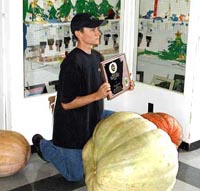Resource Library
Plant of the Week: Pumpkin, Dill's Atlantic Giant
The University of Arkansas System Division of Agriculture does not promote, support or recommend plants featured in "Plant of the Week." Please consult your local Extension office for plants suitable for your region.
Plant of the Week
Dill's Atlantic Giant Pumpkin
Latin: Cucurbita pepo

In today’s troubled times the word "fanatic" conjures up images of religious zealots waving AK-47's in the air, but lest we forget, the gentle art of gardening too has more than its share of fanatics.
The group of gardeners involved in growing giant vegetables must surely fit into Webster’s definition of "a person possessed by an excessive zeal for and uncritical attachment to a cause."
Growing giant vegetables that require a fork lift to harvest probably seems perfectly normal to those afflicted by the bigness bug, but the rest of us have questions. For example, what exactly do you do with a 900-pound pumpkin that is too small to be competitive in today’s giant pumpkin contest?
Pumpkins, Cucurbita pepo, belong to the cucumber family and are closely allied to cucumbers, gourds and winter squash. Strains such as ‘Dill’s Atlantic Giant,’ apparently the most popular for growing the giants, is not your average run of the mill jack-o-lantern type pumpkin. True, they are orange and grow on a vine but there the similarity ends. The fruit of the giants are more or less pear shaped and somewhere in size between your average steamer trunk and VW beetle.
Geneva Emmons, who gardens in the Clackamas, Oregon, exhibited a new world record pumpkin in early October that weighed 1,262 pounds. The 1,000-pound mark was broken in 1996, so it shouldn’t be long before we reach the ton mark and have some really serious rotten pumpkin issues with which to deal.
Arkansans have not been unaffected by the bigness bug. Every year more than 1,800 Arkansas 4-H youth participate in the Giant Watermelon and Pumpkin competition supervised by Craig Andersen, a Cooperative Extension Service vegetable specialist in Fayetteville. Andersen has been conducting the competition for 15 years with the official weigh-off at the Arkansas State Fair. The event is jointly sponsored by the Arkansas State Horticulture Society and the Arkansas Farm Bureau.
This year’s winner was Jarrod Beary of Walnut Ridge who exhibited a 201-pound pumpkin. Jarrod was in his ninth year of participation in the contest. The Beary family has somewhat of a dynasty in the Arkansas giant pumpkin world because his older brother Jonathan won last year with a 226-pound fruit, the largest so far grown in the program.
The gardeners who consistently produce the 1,000-pound plus pumpkins come from the Pacific Northwest, New England or adjacent sections of Canada, and the Ohio River Valley. The long daylight hours of the northern summers coupled with their more moderate summer temperatures are ideal for growing really big fruit.
Big pumpkin growers give their vines plenty of room in a deep, fertile soil. Some erect plastic greenhouses so they can plant earlier in the spring. Once the vine is off and growing, the first few female flowers are removed to ensure the plant is well established before it takes on the burden of supporting its giant offspring. Once a fruit has set, all additional flowers are removed so that only one pumpkin is allowed to grow per vine.
By judicious application of water and fertilizer, the pumpkin will continue to grow through the summer and fall. Insects such as squash beetles and diseases such as powdery mildew are serious problems in Arkansas and teach the participating 4-H youth valuable lessons about the balance of nature and the frustrations of farming.
By: Gerald Klingaman, retired
Extension Horticulturist - Ornamentals
Extension News - November 2, 2001
The University of Arkansas System Division of Agriculture does not maintain lists of retail outlets where these plants can be purchased. Please check your local nursery or other retail outlets to ask about the availability of these plants for your growing area.